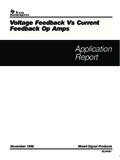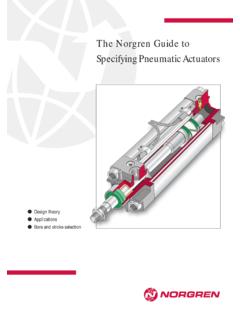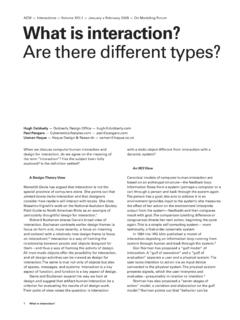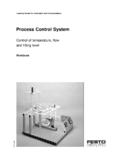Transcription of P&IDs AND LOOP DIAGRAMS - Integrated Systems
1 Industrial Instrumentation An Introduction AN OVERVIEW OF INDUSTRIAL MEASUREMENT AND CONTROL Systems . Level 1 Bryon Lewis INDUSTRIAL MEASUREMENT AND CONTROL Systems . Level 1. Introduction This course will introduce the methods to apply instrumentation and control for use in industrial processes. It will show the proper way to install and calibrate basic instruments, as well as the use of controllers, control modes, and control loops . Industrial instrumentation employees the use of applied physics to monitor and regulate processes. Instrumentation can be found in any number of the following industries, gas and petrochemical, food processing, pharmacutical, paper and pulp, waste water and water treatment plants are just a few examples.
2 Objectives The objectives of this course will be as follows . 1. Read P&IDs (process and instrumentation DIAGRAMS ). 2. Read instrument loop DIAGRAMS . 3. To be able to install and calibrate basic instruments. 4. Apply basic instrumentation to control an industrial process. 5. Apply simple design of control loops used in processes. 6. Understand feedback, feedfoward, cascade and ratio control. Industrial Instrumentation 1 Bryon Lewis Level 1 2002 all rights reserved INDUSTRIAL MEASUREMENT AND CONTROL Systems . Part 1 Course Objectives Basic Instruments 1. Instrumentation Symbols and Terminology a.
3 Symbols, nomenclature and usage b. P&IDs, Mechanical Flow DIAGRAMS c. Loop DIAGRAMS 2. Basic Measurements a. Basic Concepts i. Standard signals used in instrumentation ii. Instrument ranging and limitation iii. Span, Upper range value and Lower range value iv. Constant current and constant voltage v. Static equilibrium in instrument measurements vi. Open Systems vii. Closed Systems b. Pressure measurements i. Static pressure and Head measurements ii. Differential pressure and Head measurements iii. Vacuum measurements iv. Calibration c. Level measurements i.
4 Wet Legs ii. Suppressing the Zero iii. Elevating the Zero d. Temperature measurements i. Thermocouples 1. J type, K type, E type, T type (most commonly used). ii. RTD (resistance temperature detectors). 1. 100 ohm platinum (most commonly used). 2. Bridge measurement application 3. Constant current measurement application iii. Capillary tubes and thermometers e. Flow and Mass Flow measurements i. Differential pressure and Head to measure flow ii. Meter Types 1. Magnetic 2. Orifice 3. Venturi 4. Vortex 5. Turbine iii. Mass Flow measurement 1. Electrical and Mechanical 2.
5 Pressure + Delta Pressure + Temperature 3. Mass flow is proportional to Force measured 3. Open discussions of applications and experiences Industrial Instrumentation 2 Bryon Lewis Level 1 2002 all rights reserved INDUSTRIAL MEASUREMENT AND CONTROL Systems . Part 2 Course Objectives Process Control 1. Control loops a. Principles of operation and terminology b. Open loop control c. Closed loop control d. Single loop controls e. Cascade controls (outer and inter loop). f. Wiring of instruments and controllers 2. Control Modes g. PID control modes i. Proportional control mode ii.
6 Integral control mode iii. Derivative control mode iv. Application of the three types of control modes h. Differential Gap Control i. Split Range Control j. Time Proportioning Control 3. Final Correction Devices k. Valves i. Type of valves ii. Valve terminology, trim, and characterization iii. Applications of equal percentage, linear and quick opening vales l. Pumps i. Types ii. Applications iii. Control and interlocking to process controller 1. Alarms 2. Starting and stopping 3. Shutdown Systems 4. Applications of measurement, process control and P&IDs 5. Open discussions of applications and experiences End of Course Industrial Instrumentation 3 Bryon Lewis Level 1 2002 all rights reserved Section 1 Basic Instruments Loop Diagram Symbols and P&IDs P&IDs AND LOOP DIAGRAMS .
7 P&IDs and loop DIAGRAMS are construction and documentation drawings that depict the flow of the process and illustrate the instrumentation control and measurement interactions, wiring and connections to the process. The process is illustrated in sections or subsystems of the process called loops . A. loop diagram will detail the connections of pneumatics and wiring from the field device through any junction boxes or marshalling cabinet to the controller or computer interface which controls the process a single loop or a cascade loop of the process. This section will focus on the standard symbols, identification tags and terminology used in the industry.
8 In the areas of engineering, design, drafting, installation and maintenance of an industrial instrumentation and control system, a solid understanding of the symbols and terminology used to depict the process system is required. This course will use the ISA/ANSI standards shown in this section for all process illustrations. ISA (International Society of Automation) / ANSI (American National Standards Institute). Instrument line symbols ALL INSTRUMENT LINES ARE TO BE DRAWN FINE IN RELATION TO THE PROCESS PIPING LINES. Common connecting lines Connection to process, or instrument supply: Pneumatic signal: Electric signal: Capillary tubing (filled system): Hydraulic signal: Electromagnetic or sonic signal (guided): Internal system link (software or data link): Source: Data from ISA standard Industrial Instrumentation 4 Bryon Lewis Level 1 2002 all rights reserved Section 1 Basic Instruments Loop Diagram Symbols and P&IDs Tagging nomenclature The following table illustrates standard tagging to use for instrument identification.
9 P&ID TAG DESIGNATIONS. TYPICAL TAG NUMBER. TIC 103 - Instrument Identification or Tag Number T 103 - Loop Identification 103 - Loop number TIC - Function Identification T - First Letter (measured variable see table 2). - Succeeding Letters (modifier, readout or function). IC. EXPANDED TAG NUMBER. 10-PHA-5A - Tag Number 10 - Option Prefix A - Option Suffix Note: Hyphens are optional as separators The top of the tag will identify the instrument type and the bottom will identify the loop number. Refer to tagging nomenclature tables above. Remember the loop number is just a section or sub system of the process.
10 General instrument or function symbols Primary location Auxiliary location accessible to Field mounted accessible to operator operator Discrete instruments Shared display, shared control Computer function Programmable logic control 1. Symbol size may vary according to the user's needs and the type of document. 2. Abbreviations of the user's choice may be used when necessary to specify location. 3. Inaccessible (behind the panel) devices may be depicted using the same symbol but with a dashed horizontal bar. Source: Data from ISA standard Industrial Instrumentation 5 Bryon Lewis Level 1 2002 all rights reserved Section 1 Basic Instruments Loop Diagram Symbols and P&IDs The table below shows the recommended tag identification letters for instruments and control element designations used in P&IDs and Loop DIAGRAMS .





